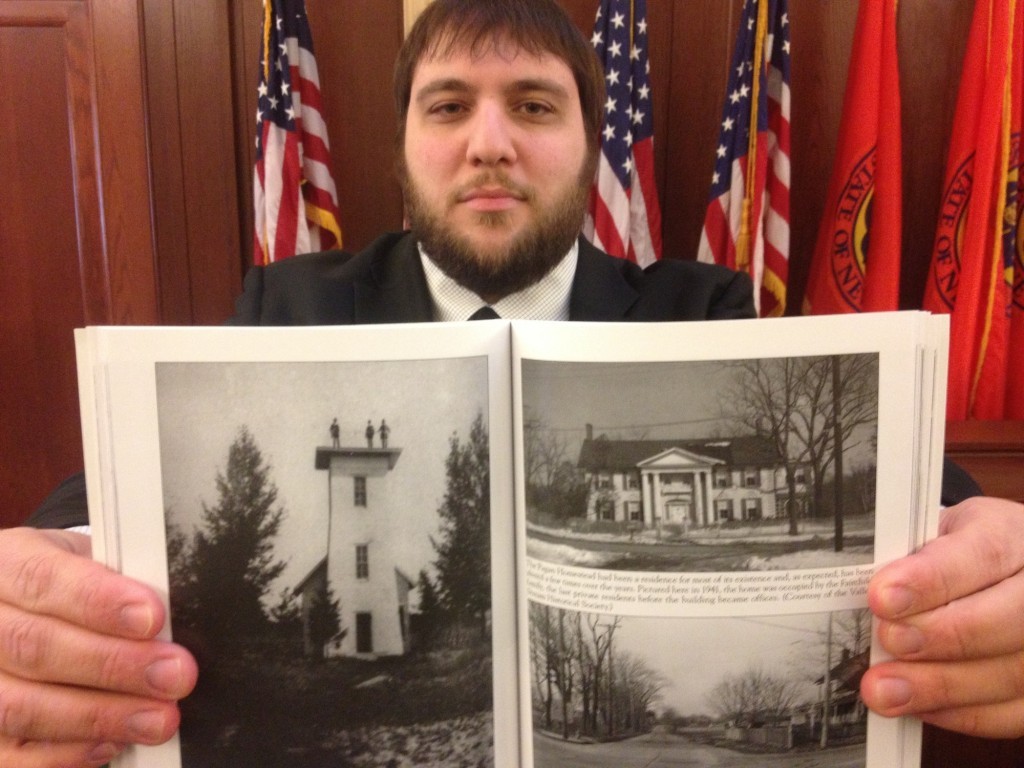Pictorial history of village published
A local historian’s project became a reality on Monday with the release of the “Images of America” Valley Stream edition, authored by local resident Bill Florio.
The project started in November 2013, when Florio learned that a coworker’s daughter had authored the Franklin Square edition of the series by Arcadia Publishing.
“Her daughter is younger than me,” said Florio, 30, a member of Nassau County’s special projects team who manages the county’s website, social media and other projects. “I’m like, ‘Well if anyone can basically do this, how do I do this?”
He had always wondered why his village didn’t have its own book, so he submitted his resume and other historian activities to the company and was accepted. He started collecting old photographs — 193 in total, including the book’s cover.
Florio’s goal was to find images of the village that hadn’t been seen before. Some were harder to come by than others. A few weeks before his deadline, he received a photo of patrons lined up around the block to purchase Rolling Stones tickets at Frogs on Rockaway Avenue, donated by Ferdinando “Freddy Frogs” Toscano’s sister, Marie Roman.
Another personal favorite, he said, is the fire lookout tower that used to exist behind the Flagan-Fletcher Restoration before the structure burned down in 1931. The 1926 groundbreaking for the Valley Stream Theatre, later known as the Rio, adorns the cover.
Compiling the photos was a trip back through village history, Florio said, in all its various phases: the speakeasy hotels in the Rum Junction area, including the drag club known as the Bird Cage, which federal agents raided in the 1920’s; the prostitutes who gave the Cookie Hill area its moniker; the Ku Klux Klan’s local prominence during the same period, when the negligible non-white population meant the group directed its anger toward Catholic residents of Italian and Irish background.
Florio’s research revealed other interesting tidbits, like the location of a house on Adeline Pl. near the Brooklyn Ave. School where the infamous Lonely Hearts Killers, the serial-killing duo of Raymond Fernandez and Martha Beck, once lived during the late 1940’s when they were committing their sinister deeds.
Less sensational but as interesting, he said, was learning about the layout and naming of the roads he grew up traveling. There’s the Old Central Ave. curve that bends into Mill Brook because Mill Rd. didn’t exist yet. There’s Hungry Harbor Rd., which turns into Rosedale Rd. before turning back into Hungry Harbor Rd. for one block past the Queens border. The Valley Stream portion was named later than the block in Queens because the road led to a poor squatter community around Hirst Dock on Motts Creek.
Florio also learned about some of the personalities whose names loom large in the village, like former mayor Louis Hicks, who was defeated by Henry Waldinger in 1927 after rumors circulated that Hicks was affiliated with the local KKK chapter, known then as the Valley Stream Social Club.
In more recent history, during the 1970’s and ‘80’s, Florio said Valley Stream earned a reputation like that of the East Village, with punk bands playing nightclubs like Legz, Carlucci’s and the Coral Inn. Metallica once played the Rio, Florio noted.
A book release party and signing was held at Sip This on Tuesday, and Florio said the book will be available in select businesses around town as well as online through Amazon and the Barnes and Noble website. He said his ultimate hope for it is that it inspires residents to think more about their community’s history — and its future.
“Maybe we can have the East Village of Nassau County again,” he said.

 48.0°,
Mostly Cloudy
48.0°,
Mostly Cloudy 




